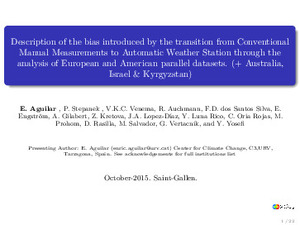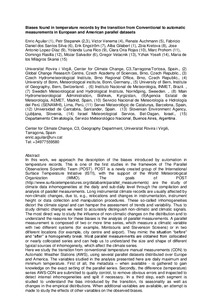Por favor, use este identificador para citar o enlazar este ítem:
http://hdl.handle.net/20.500.11765/11974
Description of the bias introduced by the transition from Conventional Manual Measurements to Automatic Weather Station through the analysis of European and American parallel datasets (+ Australia, Israel & Kyrgyzstan)
Registro completo de metadatos
| Campo DC | Valor | Lengua/Idioma |
|---|---|---|
| dc.contributor.author | Aguilar, Enric | es_ES |
| dc.contributor.author | Stepanek, Petr | es_ES |
| dc.contributor.author | Venema, Victor K. C. | es_ES |
| dc.contributor.author | Auchmann, Renate | es_ES |
| dc.contributor.author | Silva, Fabricio Daniel dos Santos | es_ES |
| dc.contributor.author | Engström, Erik | es_ES |
| dc.contributor.author | Gilabert Gallart, Alba | es_ES |
| dc.contributor.author | Kretova, Zoia | es_ES |
| dc.contributor.author | López Díaz, José Antonio | es_ES |
| dc.contributor.author | Luna Rico, Yolanda | es_ES |
| dc.contributor.author | Oria Rojas, Clara | es_ES |
| dc.contributor.author | Prohom Duran, Marc | es_ES |
| dc.contributor.author | Rasilla, Domingo | es_ES |
| dc.contributor.author | Salvador, Mozar | es_ES |
| dc.contributor.author | Vertacnik, Gregor | es_ES |
| dc.contributor.author | Yosefi, Yzhak | es_ES |
| dc.contributor.author | Skansi, Maria de los Milagros | es_ES |
| dc.date.accessioned | 2020-06-01T08:26:15Z | - |
| dc.date.available | 2020-06-01T08:26:15Z | - |
| dc.date.issued | 2015-10 | - |
| dc.identifier.citation | 10th EUMETNET Data Management Workshop (2015) | es_ES |
| dc.identifier.uri | http://hdl.handle.net/20.500.11765/11974 | - |
| dc.description | Presentación realizada en: 10th EUMETNET Data Management Workshop celebrado en St. Gallen, Suiza, del 28 al 30 de octubre de 2015. | es_ES |
| dc.description.abstract | In this work, we approach the description of the biases introduced by automation in temperature records. This is one of the first studies in the framework of The Parallel Observations Scientific Team (POST). POST is a newly created group of the International Surface Temperature Initiative (ISTI), with the support of the World Meteorological Organization (WMO). The goals of POST (http://www.surfacetemperatures.org/databank/parallel_measurements) are the study of climate data inhomogeneities at the daily and sub-daily level through the compilation and analysis of parallel measurements. Long instrumental climate records are usually affected by non-climatic changes, due to, e.g., relocations and changes in instrumentation, instrument height or data collection and manipulation procedures. These so-called inhomogeneities distort the climate signal and can hamper the assessment of trends and variability. Thus to study climatic changes we need to accurately distinguish non-climatic and climatic signals. The most direct way to study the influence of non-climatic changes on the distribution and to understand the reasons for these biases is the analysis of parallel measurements. A parallel measurement is composed of two or more time series, which measure a climatic variable with two different systems (for example, Montsouris and Stevenson Screens) or in two different locations (for example, city centre and airport). They mimic the situation “before” and “after” a homogeneity break. Most parallel measurements are obtained from collocated or nearly collocated series and can help us to understand the size and shape of different typical sources of inhomogeneity, which affect the climate series. Here we study the transition from conventional temperature manual measurements (CON) to Automatic Weather Stations (AWS), using several parallel datasets distributed over Europe and America. The variables studied in the analysis presented here are daily maximum and minimum temperature. First of all, the metadata – when available - is gathered to gain knowledge on the exact setting of the parallel series. Secondly, the difference (temperature) series AWS-CON are submitted to quality control, to remove obvious errors and inspected to detect internal inhomogeneities and split if necessary. In a third step, each segment is studied to understand the bias introduced by the transition, its seasonality as well as changes in the empirical distributions. When additional variables are available, an attempt is made to study the effects of other variables on the observed biases. | es_ES |
| dc.description.sponsorship | With the support of Grant CGL2012-32193, Ministerio de Economía y Competitividad, MINECO, España and FP7-SPACE-2013-1 grand 607193, Uncertainties in Ensembles of Regional Reanalyses (UERRA). | es_ES |
| dc.language.iso | eng | es_ES |
| dc.subject | Climate data | es_ES |
| dc.subject | Climate records | es_ES |
| dc.subject | Climatic changes | es_ES |
| dc.title | Description of the bias introduced by the transition from Conventional Manual Measurements to Automatic Weather Station through the analysis of European and American parallel datasets (+ Australia, Israel & Kyrgyzstan) | es_ES |
| dc.type | info:eu-repo/semantics/conferenceObject | es_ES |
| dc.rights.accessRights | info:eu-repo/semantics/openAccess | es_ES |
| Colecciones: | Otras presentaciones-congresos | |
Ficheros en este ítem:
| Fichero | Descripción | Tamaño | Formato | ||
|---|---|---|---|---|---|
| 11_Aguilar_Slides_web... | 7,77 MB | Adobe PDF |  Visualizar/Abrir | ||
| Aguilar_Abstract.pdf | 72,86 kB | Adobe PDF |  Visualizar/Abrir |
Los ítems de Arcimis están protegidos por una Licencia Creative Commons, salvo que se indique lo contrario.





